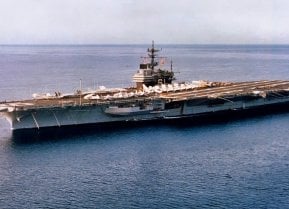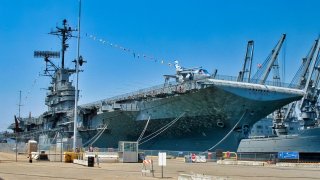USS Hornet: A U.S. Navy Aircraft Carrier Oozing with Firepower
One of the most recognized Essex-class carriers with the USS Hornet (CV/CVA/CVS-12). The hefty ship completed construction in 1943 and was shortly after assigned to the service’s primary offensive force during the war – the Fast Carrier Task Force.
Meet the USS Hornet: Aircraft carriers were arguably the most significant weapon used by U.S. forces during the Second World War. These large and well-armed “floating airports” sent aircraft aloft to locate and sink German vessels, helping to turn the tide in the war.
Carriers also supported key amphibious landings while preserving critical merchant shipping capabilities. The range that these warships provided was truly an unparalleled capability. The Japanese attack on Pearl Harbor provided the best evidence that aircraft carriers were the premiere ships during the Pacific War specifically. In fact, some of the fiercest battles of the war were conducted by aircraft and the ships they took off from never saw each other.
The U.S. Navy’s prioritization of the aircraft carrier as the dominant weapon of its strategy during the Second World War was perhaps best exemplified by the Essex-class ships. From 1943 to 1950, two dozen of these formidable carriers were constructed in shipyards in Philadelphia, Newport News, Brooklyn, Braintree, and Norfolk. Over time, this class of carriers would provide the foundations of U.S. Naval power projection through multiple major wars. Before the emergence of the Essex ships, the service’s preceding carriers were smaller in size due to the 1922 Washington Naval Treaty. Despite this, however, the Navy tested its carriers extensively in drills and exercises to ensure their capabilities if war were to erupt. Notably, Japan withdrew from the international Naval Treaty in the early 1930’s in order to build up its own naval arsenal.
Which carriers preceded the Essex-class Aircraft Carriers?
Prior to the development of the Essex-class, the Navy heavily relied on its latest carriers from the Yorktown-class. With greater power projection in mind, engineers designed the Essex-class carriers to be much longer and heavier than their predecessors. Most importantly, the new ships were constructed with wider flight decks and a deck-edge elevator that allowed for more efficient aviation operations. By the time the development of the Essex carriers emerged, armor protection and other factors had been greatly improved upon.
Essex-class ships initially measured at 872 feet in length and displaced 27,100 long tons. In the carriers’ engine rooms, steam turbines replaced the typical turbo-electric designs of proceeding classes of vessels. Four boiler rooms and two engine rooms were incorporated at the centers of each carrier, equipped with two Babcock and Wilcox boilers. These more advanced steam turbines allowed the vessels to travel up to 20,000 nautical miles at a speed of 15 knots. The Essex carriers were designed to carry over 100 aircraft, including 25+ fighters, 37 dive or scout bombers, 18 torpedos, and several utility aircraft. Armament-wise, the Essex-class ships were fitted with a dozen dual-purpose guns, which were controlled by two Mk 38 directors. Earlier vessels in the Essex class sported eight quadruple 40mm Bofors anti-aircraft guns.
Introducing the USS Hornet
One of the most recognized Essex-class carriers with the USS Hornet (CV/CVA/CVS-12). The hefty ship completed construction in 1943 and was shortly after assigned to the service’s primary offensive force during the war – the Fast Carrier Task Force. The Hornet provided air support to protect the invasion beaches in New Guinea and later carried out large-scale aerial raids against Japanese bases near the Caroline Islands. The Hornet later contributed mightily to the Battle of the Philippine Sea in 1944, where it conducted strikes to take out as many land-based Japanese aircraft as possible. Following these stints, the carrier returned home to undergo extensive overhauls. Once her modernization was complete, she operated in Vietnamese waters into the mid to late 1960s.

What Makes the USS Hornet Stand Out?
The Hornet was uniquely constructed with many of her radars fitted on the tripod mast, which carried SM height-finding radar, the SK early-warning radar, and the SG surface search radar. Perhaps the greatest capability provided by the Hornet was the new generation of aircraft she carried. SB2C Helldivers, F6F Hellcats, and TBF Avengers were some of the more formidable airframes housed on the Hornet carrier.
Following more than two decades of service in 1970, the USS Hornet was finally decommissioned at the Puget Sound Naval Shipyard and Intermediate Maintenance Facility. While the supercarrier was relegated to retirement duties, the Hornet has been used in several TV shows. Most recently in 2023, CarrierCon collaborated with a popular Chinese video game that features characters like the Hornet.
Many of the Hornet’s sister ships were decommissioned in the 1970s, however, the USS Lexington remained active until the early 1990s. While each of the Essex-class ships is officially retired from service, they are well respected by naval history buffs and industry experts alike.
About the Author
Maya Carlin is an analyst with the Center for Security Policy and a former Anna Sobol Levy Fellow at IDC Herzliya in Israel. She has by-lines in many publications, including The National Interest, Jerusalem Post, and Times of Israel. You can follow her on Twitter: @MayaCarlin.


